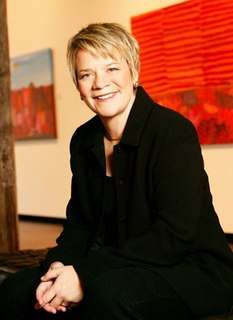|
Back
Technicolor Symphonies Houston
Jones Hall
01/07/2010 - & Jan. 9, 10, 2010
Samuel Barber: Symphony No. 1, Op. 9
Gustav Mahler: Symphony No. 1 in D Major
Houston Symphony Orchestra, Marin Alsop (conductor) 
M. Alsop (© Kym Thomson)
Marin Alsop ushered in 2010 with the Houston Symphony in a sparkling, thought-provoking program of the first symphonies of Samuel Barber and Gustav Mahler. The juxtaposition provided wonderful surface contrast, but at their hearts, the two composers have much in common, especially in their tackling of the symphonic genre. Both were masters of the art song, and their purely instrumental works were heavily influenced by their vocal writing. Further, both consciously rethought the content and structure of the symphony as a form, and created mature, fully-formed statements in their initial essays in the genre.
Alsop is renowned as a Barber specialist, and her passion and understanding of this music was clear from her baton's first gesture. Conducting from memory, she ushered in a gorgeous initial statement of the motto theme, drawing impenetrable and arresting tone from the strings. The orchestra was expertly navigated through the many potential rhythmic pitfalls in the first and second sections of the work. The tempo of the second section was a bit on the slow side, causing a slight lack of energy and lightness. The orchestra played ever so slightly behind the beat, and the accumulation to the unison, hammering rhythms at the climax of the scherzo seemed pulled back instead of thrust forward. The many difficult wind solos were effortlessly realized by the orchestra's principles. The gorgeous third section was expertly paced clear through to its shattering climax. The concluding passacaglia, like the scherzo, was taken at a rather measured tempo. Alsop seemed intent at making the high point of the work happen in the third section instead of creating momentum throughout to the very end of the work, which is simply a matter of taste. Her vision was clearly conceived and presented.
The Mahler symphony was a mixed bag. In the opening of the first movement, the requisite tension was lacking, and the many tempo changes indicated in the score failed to come across. Likewise, the gradual accelerando that is supposed to happen throughout the first theme proper simply didn't happen. "Ein frisches, belebtes Zeitmass" was never achieved, and the "noch ein wenig beschleunigen" indication was ignored. At this point, worry began to set in. The interpretation was simply coming across as too simple and steady, devoid of the manic energy that is essential even in Mahler's most pastoral passages. Alsop turned things around midway through the movement, however, and the entirety of the second half, beginning with the gorgeously played (and truly ppp!) horn quartet, swept the audience relentlessly to the scurrying last measures.
The second and third movements continued in a similar vein, providing a range of interpretive choices that was variously surprising, confounding and thrilling. Alsop took the second movement's "doch nicht zu schnell" indication too literally and lost any chance to become more leisurely in the trio. That said, the woodwinds and horns played with a rawness that gave a wonderful bucolic edge to the movement. Alsop had the entire double bass section play the opening melody of the third movement, a controversial choice derived from the recent Critical Edition of the International Gustav Mahler Society. This robs the statement of the eeriness that a solo double bass provides, but seems to be more and more common these days (Gergiev and Haitink follow suit in their recent recordings). The central dance-music featured some deliciously exaggerated rubato and dynamic contrasts from the podium, followed with aplomb by the orchestra.
The finale more than made up for any perceived shortcomings of the first three movements. At a brisk tempo, with curt articulations and brilliant playing from the entire orchestra, Alsop saved the best for last. In the slower, lyrical episodes, she channeled the third section of the Barber symphony, bathing the listener in lush string sounds and convincing phrasing. The fast sections were incisive and vehement, making the ultimate D major climax, with eight horns a-standing, all the more thrilling.
In both works, Alsop was a provocative interpreter. By the end of the concert, however, any questions that were raised were summarily dismissed. Just as all the musical and emotional complexities of Mahler's symphony resolve with the entire orchestra coming together on two octave Ds, the performance created a wonderful narrative, moving from moments of confusion through periods of elucidation to a final sweep of inspiring exactitude.
Marcus Karl Maroney
|